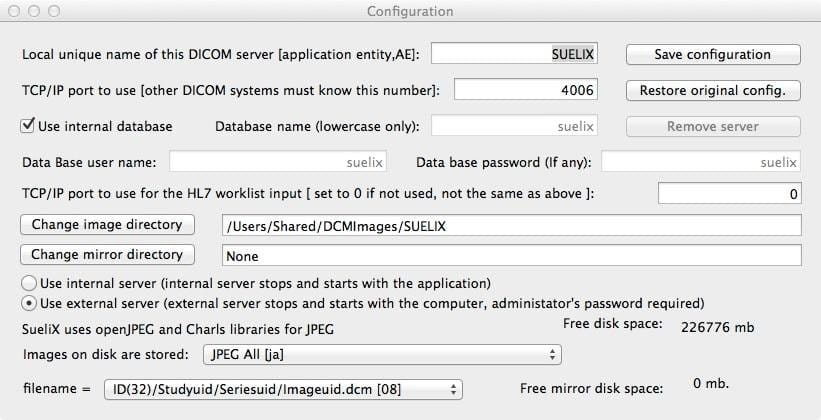10 Open-source Free PACS Systems for Windows, Linux, macOS in 2024
Table of Content
In 2024, the availability of open-source PACS (Picture Archiving and Communication Systems) is transforming how hospitals and healthcare providers manage medical imaging.
This post explores 10 of the best open-source PACS systems that are compatible with Windows, Linux, and macOS, offering a comprehensive look at solutions that can enhance the efficiency and accessibility of medical imaging.
Benefits for Decision-Makers in Hospitals:
Open-source PACS systems provide decision-makers with cost-effective alternatives to proprietary software, allowing for significant savings without compromising on functionality.
These systems are highly customizable, enabling hospitals to tailor their imaging infrastructure to meet specific needs.
The transparency of open-source solutions also ensures that healthcare organizations maintain control over their data, enhancing security and compliance with regulations. Additionally, the flexibility of these systems makes them scalable, accommodating the growing demands of a healthcare facility as it expands.
Benefits for Doctors and Healthcare Service Providers in Rural Areas:
For doctors and healthcare providers in rural areas, open-source PACS systems are game-changers. They offer an affordable way to access advanced medical imaging technology, which is often prohibitively expensive.
These systems enable remote access to imaging data, facilitating consultations with specialists in urban centers without the need for patients to travel. This improved access to imaging and expert analysis can lead to faster diagnoses and better patient outcomes.
Moreover, the use of open-source PACS can help bridge the gap in healthcare quality between urban and rural areas, ensuring that all patients receive the care they need, regardless of location.
This post will guide healthcare administrators and IT professionals in selecting the best open-source PACS system to meet the needs of their facility, ensuring that they can provide high-quality care while managing costs effectively.
1. Orthanc
Orthanc is a free and open-source PACS system that stands out for its simplicity and powerful capabilities, making it a top choice for hospitals. Its availability of professional and commercial support further strengthens its position as a reliable solution for managing DICOM workflows in healthcare environments.
Orthanc is designed to streamline DICOM workflows in hospitals and support medical image research. Its standout feature is a RESTful API that enables easy integration with any programming language, allowing users to interact with and manage DICOM files seamlessly.
Orthanc can convert any computer running Windows, Linux, or macOS into a DICOM store, functioning as a lightweight, standalone mini-PACS system without the need for complex database administration or third-party dependencies.
Orthanc Features
- Easy to install, setup and configure
- Lightweight app
- Comes with a RESTful API
- Supports many DICOM formats
- Supports MySQL or PostgreSQL for database backend
- Web-based setup
- Works on Windows, Linux and macOS

2. dcm4che
dcm4che is a comprehensive, open-source suite of applications and libraries for managing and processing DICOM (Digital Imaging and Communications in Medicine) data.
As a PACS (Picture Archiving and Communication System) solution, dcm4che provides tools for the storage, retrieval, and viewing of medical images, offering robust capabilities for healthcare facilities.
dcm4che is particularly valued for its flexibility and comprehensive feature set, making it suitable for both small clinics and large hospital networks looking to implement a robust and scalable PACS solution.
Key Features of dcm4che as a PACS System:
- DICOM Support: dcm4che fully supports the DICOM standard, allowing for the management of medical images across different modalities (e.g., CT, MRI, X-ray).
- Archiving and Storage: It provides scalable storage solutions, enabling healthcare providers to store large volumes of medical images securely and efficiently.
- Image Retrieval and Query: dcm4che supports advanced querying and retrieval of DICOM images, facilitating the efficient management of imaging data.
- Integration with Other Systems: It can be integrated with other healthcare IT systems such as EHR (Electronic Health Records) and RIS (Radiology Information Systems), providing a seamless workflow.
- Web-based DICOM Viewer: dcm4che includes a web-based viewer for DICOM images, enabling remote access to images and reports from any location.
- Extensibility: As an open-source solution, dcm4che can be extended and customized according to specific needs, making it a versatile tool for healthcare providers.
- Community and Support: While it is open-source, dcm4che has a strong community and support network, making it a reliable choice for hospitals and clinics looking to implement a PACS system.
3. Conquest DICOM Server
Conquest DICOM Server is a robust, open-source DICOM server that provides a reliable solution for storing, retrieving, and managing medical images in healthcare environments.
The app is designed to be lightweight and easy to install, making it an accessible choice for small to medium-sized medical facilities, as well as research institutions.
Conquest DICOM Server is ideal for healthcare providers looking for a cost-effective, scalable PACS solution that offers the flexibility to meet a wide range of imaging needs.
Features of Conquest DICOM Server
- DICOM Compatibility: Fully compliant with the DICOM standard, ensuring seamless integration with various imaging modalities like MRI, CT, and X-ray machines.
- Multi-Platform Support: Available for Windows and Linux, making it versatile for different IT environments.
- Database Integration: Supports various database back-ends, including MySQL, SQLite, and PostgreSQL, for efficient image storage and retrieval.
- Web Interface: Comes with a web-based interface for easy management and monitoring of DICOM images and server status.
- Custom Scripting: Allows for custom scripts using languages like Lua, enabling automation and customization of workflows.
- Image Compression: Supports image compression using JPEG, JPEG2000, and other formats, optimizing storage without compromising image quality.
- DICOM Query/Retrieve: Facilitates advanced querying and retrieval of images, making it easy to access specific patient data or studies.
- Modality Worklist (MWL): Includes MWL support, improving workflow efficiency by allowing imaging devices to retrieve patient and scheduling information directly from the server.
- User Management: Features robust user management capabilities, including access control and audit logging to ensure compliance with data protection standards.
- Community Support: Backed by an active community, providing regular updates and support, making it a reliable choice for long-term use.
4. ClearCanvas
ClearCanvas is an open-source DICOM Server and PACS (Picture Archiving and Communication System) solution that offers a comprehensive set of tools for managing and viewing medical images.
Designed to be user-friendly and highly customizable, ClearCanvas is well-suited for both clinical environments and research purposes. It provides a seamless workflow for storing, retrieving, and analyzing medical images, making it a valuable tool for healthcare professionals.
ClearCanvas DICOM PACS is an effective and accessible solution for managing medical imaging, providing essential features for healthcare providers and researchers.
ClearCanvas's features
- DICOM Support: Fully compliant with DICOM standards for medical imaging, ensuring compatibility with various imaging modalities.
- PACS Integration: Functions as a complete PACS solution, offering image storage, retrieval, and management.
- Image Viewing: Includes a DICOM image viewer with advanced visualization tools, allowing for detailed analysis of medical images.
- Worklist Management: Supports DICOM Modality Worklist (MWL) for efficient patient and study management.
- User-Friendly Interface: Offers an intuitive and easy-to-navigate interface, suitable for users with varying levels of technical expertise.
- Customizable Workflow: Provides tools for customizing the workflow to meet specific needs, including scripting and plugin support.
- Multi-Platform Support: Available for use on Windows, with future considerations for cross-platform compatibility.
- Community and Commercial Support: Offers both community-driven support and optional commercial support for more extensive needs.
5. Dicoogle
Dicoogle is an open-source Picture Archiving and Communications System (PACS) archive that offers a flexible and extensible platform for managing medical images. Its modular architecture allows for easy expansion and customization, making it ideal for healthcare institutions that require tailored solutions.
It is built as a robust and adaptable PACS archive solution, offering essential features for efficient medical image management and the flexibility to grow with the evolving needs of healthcare institutions.
Dicoogle provides a Software Development Kit (SDK), enabling developers to quickly build and integrate new functionalities. This makes it a versatile tool for both clinical and research environments, allowing users to adapt the system to their specific needs while maintaining compliance with DICOM standards.
Dicoogle's Features
- DICOM Compliance: Fully supports the DICOM standard, ensuring compatibility with various medical imaging devices and systems.
- Modular Architecture: Offers a highly modular design that allows users to customize and extend the system easily, adapting it to specific needs.
- Software Development Kit (SDK): Provides an SDK for developers to create and integrate custom functionalities, enhancing the flexibility of the platform.
- Search and Indexing: Features advanced search capabilities, including full-text indexing of DICOM metadata, enabling quick and efficient retrieval of medical images.
- Web-Based Interface: Includes a user-friendly, web-based interface for managing, querying, and retrieving DICOM files, accessible from any device with a browser.
- Plugin Support: Allows the addition of plugins to extend the system’s capabilities, such as adding new data sources or integrating with other healthcare systems.
- Multi-Platform Support: Runs on multiple operating systems, including Windows, Linux, and macOS, providing versatility in deployment.
- Scalability: Capable of handling large volumes of medical images, making it suitable for institutions of various sizes.
- Open-Source: Being open-source, Dicoogle allows users to inspect, modify, and contribute to the codebase, fostering a collaborative development environment.
- Customizable Workflows: Supports the customization of workflows, enabling healthcare providers to optimize processes according to their specific requirements.

6. SueliX (macOS)

Suelix is a DICOM PACS server designed specifically for macOS, providing a simple and straightforward solution for managing medical images. It is a macOS interface to the well-known Conquest DICOM PACS server, which has been widely used in the Windows environment. Suelix leverages the dgate server at its core and introduces several enhancements, such as JPEG-LS compression and an HL7 worklist server, making it a robust tool for healthcare professionals who need a reliable PACS solution on macOS.
Suelix offers a user-friendly, efficient solution for medical image management on macOS, making it a valuable tool for healthcare providers who need a reliable PACS system.
Features List
- DICOM PACS Server: Fully functional server for storing, retrieving, and managing DICOM medical images.
- HL7 Listener: Integrated HL7 listener for seamless communication with other healthcare systems.
- Worklist Server: Supports DICOM modality worklist, improving workflow efficiency.
- JPEG-LS Compression: Enhanced image compression support, optimizing storage without sacrificing image quality.
- Database Options: Utilizes either an internal SQLite database or a MySQL interface for flexible data management.
- MacOS Compatibility: Specifically designed for easy setup and use on macOS, requiring minimal configuration.
7. EasyPACS - Dicom Server
EasyPACS provides a comprehensive and easy-to-use solution for managing medical images, suitable for a variety of healthcare environments. It uses DCM4CHEE listener and converts dicom files into jpegs. It is the easiest way to store dicom files.
EasyPACS is the simplest PACS server for your dicom files.
Features of EasyPACS
- DICOM Compliant: Fully supports DICOM standards for medical image management.
- User-Friendly Interface: Designed with an intuitive interface, making it easy to set up and use without extensive training.
- Cross-Platform Compatibility: Works on multiple operating systems, including Windows and Linux.
- Image Storage and Retrieval: Provides reliable storage and quick retrieval of medical images, ensuring efficient workflow.
- Database Support: Integrates with various database systems for flexible and scalable image management.
- Web-Based Access: Allows for remote access and management of images through a web interface.
- Modality Worklist Support: Includes support for DICOM modality worklists, enhancing workflow efficiency.
- HL7 Integration: Supports HL7 standards for seamless communication with other healthcare systems.
- Image Viewing: Offers built-in DICOM image viewing capabilities for quick and easy image analysis.
- Security Features: Includes encryption and access control to ensure the security and privacy of medical data.

8. NeurDICOM
NeurDICOM is portable and easy-to-deploy RESTful DICOM and PACS server that allows physicians to use state-of-the-art methods of machine learning and neural networks to make a diagnosis based on medical images processing and interpretation.
9. pynetdicom
A Python implementation of the DICOM networking protocol, originally based on (legacy) pynetdicom.
10. dicomweb-server
This is a free and open-source Lightweight DICOMweb Server with CouchDB.
These PACS solutions support a range of operating systems, offering essential features for medical imaging, including DICOM support, image storage, and viewing capabilities.













